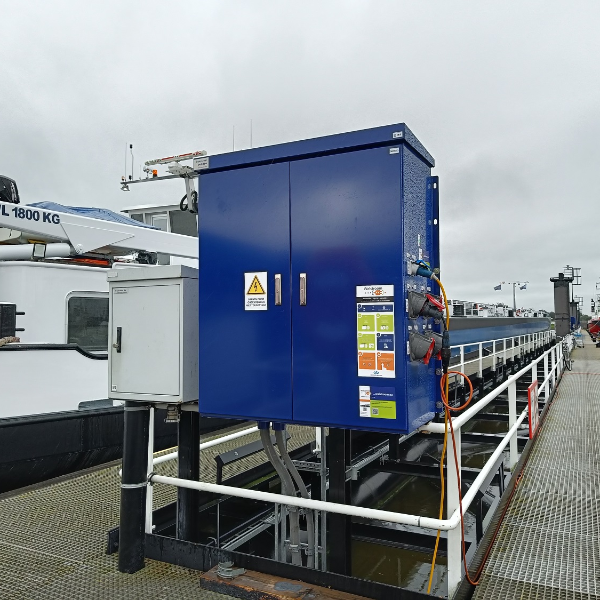Safer, affordable and smart shore power system for Groningen Seaports

Safer, affordable and smart shore power system for Groningen Seaports
High energy costs and a severely outdated network of shore power systems forced Groningen Seaports to take action. The port authority engaged Witteveen+Bos to modernise the network and make it ready for pay on demand.
Groningen Seaports operates multiple locations in Delfzijl and Eemshaven where inland vessels use shore power facilities. Depending on the location, these facilities are very outdated and sometimes already decommissioned because they are no longer safe to use.
Moreover, insight into the energy drawn from the shore power cabinets was lacking. In addition, the payment system was based on a fixed percentage which was added to the port dues.
This payment principle and the lack of registration means that Groningen Seaports could not pass on the increased energy bills to consumers on a one-to-one basis. The port authority wants to achieve the latter by giving shippers insight into their power consumption and have them pay accordingly.
Challenge
Groningen Seaports asked Witteveen+Bos to design the renovation. This consisted of taking stock of current facilities, translating Groningen Seaports’ wishes into a design, and researching and advising on different payment systems.
The state of the current facilities varied quite a lot across the various locations. Some locations had already been renovated before while other locations had not been touched for years.
Groningen Seaports therefore decided to replace all shore power cabinets by a standardised design. This did, however, prove to be challenge as the requirements of Groningen Seaports were rather broad and could not be applied at every location.
Safe solution
Ultimately, the port authority selected several models with a distinction between a ‘light’ and a ‘heavy’ shore power cabinet. This was mainly because of the size and capacity of the available connections. For instance, more connections of up to 125 A have been created to provide shore power to larger vessels in the future.
These are neatly incorporated into the side of the cabinet with indicators showing whether the connection is available or in use, or in fault mode. Smart technology is used which allows the RCD to be switched back on using a small motor.
This can be done at the push of a button on the outside of the cabinet. This makes the cabinet inaccessible to unauthorised persons, while allowing the RCD to be reset. This saves the deployment of the breakdown service if the RCD is tripped. This is a common problem with shore power facilities.
Pay on demand
As stated earlier, the payment system has been adapted to modern times. The choice was made for a pay-on-demand system for which shippers register and pay for actual consumption. This approach also compels them to use energy efficiently.
The port authority can also use the underlying software programme to monitor how much power is currently being drawn. This allows it to enable or disable additional connections, based on the available capacity. This way, the port authority can guarantee that it can deliver the requested power when a connection is available.
Smooth transition
Skippers can use the European network walstroom.eu to check which shore power facilities are available at each location. Before their arrival, they can check which connections are available at each location.
In September 2023, Groningen Seaports commissioned the new shore power network. The initial feedback is that the transition to the new system has been smooth and that the new shore power cabinets are user-friendly for shippers. The level of insight into consumption and whether it is managed better will have to be seen in the long run.